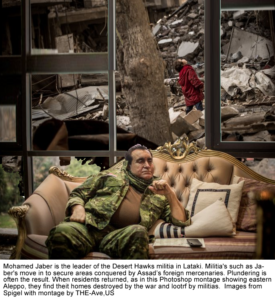
Assad’s Warlords Gain Upper Hand
 On a cool morning, an elderly man is standing at his espresso machine on a street in eastern Aleppo. It’s shortly after 8 a.m., and this part of the city — destroyed in the war and reconquered by the regime in December — is waking up. Green grocers arrive and set out their boxes of produce on the rubble piled in front of their stores. Others are shoveling debris from the roads.
On a cool morning, an elderly man is standing at his espresso machine on a street in eastern Aleppo. It’s shortly after 8 a.m., and this part of the city — destroyed in the war and reconquered by the regime in December — is waking up. Green grocers arrive and set out their boxes of produce on the rubble piled in front of their stores. Others are shoveling debris from the roads.
Inside, he found uniformed fighters from a militia affiliated with the regime. They were in the process, he says, of removing a motorcycle, his German tools and all replacement parts from the garage. Two of the militia members, he says, silently threatened him with their Kalashnikovs, leaving him no choice but to leave as the men loaded his belonging into a pick-up truck.
As he relates his story, other civilians approach the fire and begin nodding. One of them, the owner of a general store, says that regular army soldiers had hardly left before militia members began emptying out his store. Another relates the story of how militia members murdered his brother. The brother had been lying wounded in bed when five fighters forced their way into his apartment. “Bring him out,” the fighters ordered before claiming the apartment as their own. The man protested, saying his brother was unable to walk — whereupon one of the militia members pulled out his gun and shot the brother in the head. Then the fighters looted the apartment.
The Real Power-Holders
For months, Assad’s army has been on the advance across Syria. But its military success has only been possible due to the significant assistance the president’s troops have received from Iran and Russia — and from local Syrian militias. Now, these fighters are taking over control in many areas, committing murder, looting and harassing civilians. And nobody can stop them, not even Assad himself. Indeed, the militias are now more powerful than even the country’s leader and have become the real holders of power in Syria.
Even long before the Syrian revolt of 2011, Assad depended primarily on the loyalty of his fellow Alawites in the top ranks of the armed forces and intelligence services. But the religious group only makes up between 12 and 15 percent of the Syrian population. In 2012, Assad’s position became even more tenuous as the army began shrinking rapidly: Tens of thousands of soldiers deserted, conscripts failed to show up for duty and many of those who did fight ended up dead. In September 2015, when the Russians joined the war, the Syrian army only had 6,000 soldiers who were fit for active duty, according to Charles Lister of the Middle East Institute in Washington. He bases his estimate on confidential testimony of Russian officials.
Bread, gasoline, medication — there are shortages across the entire country. And those who control the distribution of these goods can profit handsomely, enabling them to purchase more weapons and hire more fighters. As a result, the warlords have replaced the state security apparatus in cities and in entire regions.
While the Syrian army, in its desperation, has been forced to combs jails for recruits, fighters join the militias of their own free will. Some of them, after all, pay up to three times the salary earned by regular soldiers and they have a lot more freedom. They can, for example, extort duties at checkpoints, sell drugs of their own accord, smuggle gasoline and loot conquered towns and villages.
Securing the Conquered Territory
Assad is nevertheless dependent on them. When his troops, supported by Russian units, took eastern Aleppo in December 2016, the Syrian soldiers featured prominantly in front of the television cameras. But the actual fighting was conducted by Iraqi, Afghan and Lebanese mercenaries under Iranian senior leadership — and by the pro-regime militias, who also secured the conquered territory once the fighting had ceased. And they plundered it.
Regime-held territory today is similar to areas under rebel control — splintered and characterized by shifting alliances. Hundreds of groups with competing loyalties have taken control, earning money from the war and controlling their territory through fear.
Hama is one of those places, a veritable warlords’ el Dorado. In 1982, troops loyal to Hafis Assad, the founder of the Assad dynasty, brutally crushed an uprising, killing more than 10,000 people in just three weeks. More recently, the city is where the Tiger Forces were founded, formed out of a loose network of officials from the feared air force secret service, local tribal leaders and criminals. They gathered around an Alawite officer and helped crush the anti-regime rebellion in the province of Hama in 2011. Now, the militia has bases and networks in several parts of Syria.
